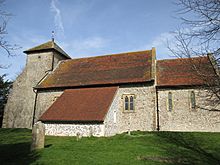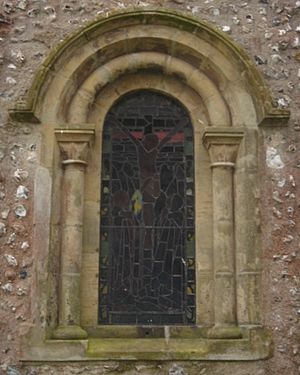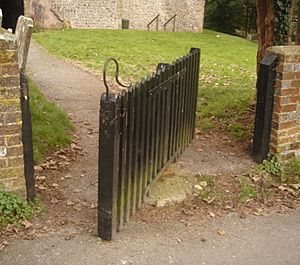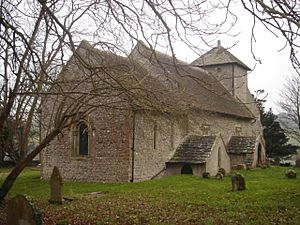Church of the Transfiguration, Pyecombe facts for kids
Quick facts for kids Church of the Transfiguration |
|
|---|---|

The church from the southeast
|
|
| 50°53′54″N 0°9′52″W / 50.89833°N 0.16444°W | |
| Location | Church Hill, Pyecombe, Hassocks, West Sussex BN45 7FE |
| Country | England |
| Denomination | Anglican |
| History | |
| Status | Parish church |
| Dedication | Transfiguration of Jesus |
| Architecture | |
| Functional status | Active |
| Heritage designation | Grade I |
| Designated | 28 October 1957 |
| Style | Medieval |
| Administration | |
| Parish | Pyecombe, The Transfiguration |
| Deanery | Hurst |
| Archdeaconry | Chichester |
| Diocese | Diocese of Chichester |
| Province | Province of Canterbury |
The Church of the Transfiguration is a very old church in the small village of Pyecombe, West Sussex, England. It is the main Church of England parish church for the area. Most of this special building was built a long, long time ago, in the 1100s and 1200s. It sits in a quiet spot, looking out towards the beautiful South Downs hills. Because it is so old and important, it has been given a special "Grade I" listing, which helps protect it.
Contents
History of the Church
The small village of Pyecombe is in a long, deep valley. This valley was formed by a river called the Wellesbourne. The river flows towards the English Channel at Brighton. Today, this river mostly runs underground. The South Downs hills rise to about 213 meters (700 feet) on both sides of the valley.
Pyecombe village is split into two parts. The original village grew around the church and an old path across the South Downs. Later, new buildings appeared to the west. The church was built on the west side of this old path. This path was at the center of three ancient routes across the South Downs.
The church was known as Pangdean Church in 1086. This was when the Domesday Book was written. The Domesday Book was a huge survey of land and wealth in England. At that time, a place called St Pancras Priory owned the right to choose the church's priest. In 1537, during a time called the English Reformation, this right passed to King Henry VIII.
Building the Church
The oldest parts of the church we see today are from the 1100s. These include the chancel (the area around the altar), the arch leading to it, and the main part of the church called the nave. Some experts believe these parts were built around 1170.
The Norman tower at the west end was added in the 1200s. This tower holds one bell that is from the 1400s. In 1898, the outside of the church was covered with a rough plaster. Most of this plaster has now been removed. The church also had some repair work done in 1844 and 1914.
Church Architecture and Design
The church is built facing east to west. The chancel and altar are at the east end. It has a chancel and a simple, rounded arch from the 1100s. The nave, also from the 1100s, has two rectangular windows on each side.
The short tower from the 1200s has two angled supports called buttresses. One of these supports has a gravestone from the 1200s built into it. On the north side, there is an entrance porch and a small room called a vestry. The roofs of the church, porch, and tower are covered with special tiles from Horsham.
Building Materials and Windows
Like many churches in Sussex, the main material used to build the Church of the Transfiguration was flint. Flint is a hard stone. For about 100 years, this flint was hidden under plaster. Now, it can be seen again. The areas around the windows have modern stone decorations. Some of the windows themselves are copies made in the 1800s. However, the windows in the nave are much older, from the 1400s.
Inside the Church
Inside, the chancel arch has a smaller, newer arch on each side. The tiled floor in the sanctuary (the area around the altar) is from the 1200s. These special tiles were made at St Pancras Priory. They still show designs of animals and birds.
The carved pulpit (where the priest gives sermons) is dated 1636. It was changed a bit in 1898. The lectern (where readings are given) has similar carvings. One very old item inside the church is the font, which is from the 1100s. It is made from a single piece of lead bent into a drum shape. The outside of the font has fancy designs.
The Tapsel Gate
On the north side of the churchyard, there is a very rare type of gate. It is called a Tapsel gate. These gates are unique to Sussex and were named after the Tapsel family who invented them. There are only six of these gates left in the county. All of them are found within 16 kilometers (10 miles) of Lewes. The Tapsel gate at Pyecombe was replaced in the early 1900s. The original gate was put there in the 1700s. This gate even has the hooked end of a "Pyecombe crook" built into it. A Pyecombe crook is a type of shepherd's staff made in the village since the 1700s.
Tapsel gates spin around a central pole. Even when they are fully open, they are too narrow for cattle to walk into the churchyard. But they are easier for people carrying a coffin to use than a normal gate. People can walk on each side of the gate, and the coffin can even be rested on the central pole if needed.
The Church Today
The Church of the Transfiguration is part of a group of churches called the Benefice of Poynings with Edburton, Newtimber and Pyecombe. This group includes five villages in the downland area. Each village has its own church. The other churches are St Andrew's Church at Edburton, Holy Trinity Church at Poynings, and St John the Evangelist's Church in Newtimber. The old church of the Good Shepherd at Fulking is no longer used, but it is still part of this group.
The church was given its "Grade I listed" status on October 28, 1957. This means it is a very important historic building. In January 1989, the local council also made the area around the church a special "conservation area." This helps protect its natural beauty and history.
Two church services are held each month. The Pyecombe Parish Council also holds its meetings inside the church.




